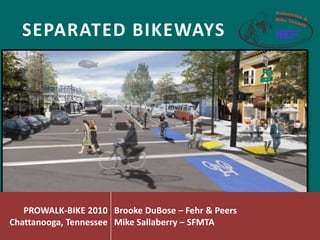Session 3: Separated Bikeways
- 1. SEPARATED BIKEWAYS PROWALK-BIKE 2010 Brooke DuBose – Fehr & Peers Chattanooga, Tennessee Mike Sallaberry – SFMTA
- 2. Agenda 1. Overview of Separated Bikeways 2. ITE Ped/Bike Council Research • Opportunities & Issues 3. Why consider them? • When and how to use them 4. Concerns, and how to design for them
- 3. Separated Bikeways Dunsmuir Cycle Track, Vancouver BC Photo Credit: AverageJoeCyclist.com
- 4. One-Way Separated Bikeways New York City Cambridge, MA Vancouver, BC
- 5. Two-Way Separated Bikeways New York, NY Montreal, QC
- 6. Facility Elements Segment Driveways Intersections Lane Width Visibility Visibility Slowing Slowing Buffer Width Vehicle Vehicle & Type Speed Speed One-way or Turning Auto Access two-way lane Movements
- 7. Agenda 1. Overview of Separated Bikeways 2. ITE Ped/Bike Council Research • Opportunities & Issues 3. Why consider them? • When and how to use them 4. Concerns, and how to design for them
- 8. ITE Informational Report Findings on the current state of practice for installing separated bikeways in North America PURPOSE 1. Summarize existing research and design guidance 2. Identify locations & design attributes of facilities already constructed in U.S. & Canada 3. Demonstrate the need for additional research on safety, latent demand, and design guidelines
- 9. Potential Latent Demand Bicycle Planning Trends: Roger Geller’s Four Types of Bicyclists Fast & Fearless - 1%> Interested but Concerned – 60% No Way, No How – 33% Enthused & Confident – 7%
- 10. Fast & Fearless Enthused & Confident Interested but Concerned
- 11. Moral of the Story: We have spent much of our Fast & Fearless - time planning for 7-8% of riders 1%> Interested but Concerned – 60% No Way, No How – 33% Enthused & Confident – 7%
- 12. Scoreboard, Baby! Bicycle Counter, Copenhagen Photo Credit: Momentum
- 13. Initial Survey Results What is your opinion on separated bikeways? 250 55% Preferable to on-road 200 facilities and should be installed where 43% possible 150 Appropriate only in limited circumstances 100 Never appropriate 50 2% 0
- 14. Initial Survey Results How important a role do you think separated bikeways have or could have in making cycling more mainstream and popular? 250 50% 200 Critical Important 150 24% Neutral 19% Not Important 100 Detrimental 4% 3% 50 0
- 15. Initial Survey Results Should separated bikeways be included in design manuals in the US and Canada? 65% 300 250 Yes 200 Yes, with proper criteria 150 Maybe 21% 100 Probably not 10% Absolutely not 50 3% 1% 0
- 16. Design Guidance •List of nine problems with separation focuses on two-way shared use paths •Discusses three types of path- roadway intersections: Midblock, Adjacent, and Complex •Provides limited design guidance •Does not prohibit separated bikeways
- 17. Cities Are Already Experimenting… Geographic Location of Separated Bikeways Total Coverage: • 45 states • 5 provinces Highest Coverage (# cities): • California – 37 • Florida – 13 • Washington – 13 • Ontario – 10
- 18. ITE Informational Report HIGHLIGHTED LOCATIONS •SW Broadway, Portland, OR •15th St, NW, Washington DC •Vassar Street, Cambridge, MA •Concord Avenue, Cambridge, MA •8th Avenue, (Manhattan) New York City, NY •9th Avenue, (Manhattan) New York City, NY •Broadway, (Manhattan) New York City, NY •Allen Street/Pike Street, (Manhattan) New York City, NY •Grand Street, (Manhattan) New York City, NY •Kent Avenue, (Brooklyn) New York City NY •Sands Street, (Brooklyn) New York City NY
- 20. Agenda 1. Overview of Separated Bikeways 2. ITE Ped/Bike Council Research • Opportunities & Issues 3. Why consider them? • When and how to use them 4. Concerns, and how to design for them
- 21. Why: Prevention of Poor Design
- 22. Why: Roadway Obstructions in Urban Areas New York City
- 23. Why: Continuity of Pathway Experience Vancouver, BC
- 24. Cyclist Comfort on Busy Roadways From London Cycling Design Standards
- 25. Cyclist Comfort on Busy Roadways State of Cycling Report, SF Top two barriers to cycling: - Not enough bike lanes - Not comfortable riding with cars
- 26. Agenda 1. Overview of Separated Bikeways 2. ITE Ped/Bike Council Research 3. Issues & Opportunities 4. Why consider them? When and how to use them 5. Concerns’ and how to design for them
- 27. Unexpected Movements Bi-directional paths can create unexpected movements at intersections and driveways Consider using single direction paths where there are many driveways and intersections
- 28. Turn Conflicts/Intersections - Bring cyclists down to roadway level - Improve sightlines - Signalize - Slow turning drivers - Add high visibility markings
- 29. Left Turns
- 30. Maintenance: Sweeping and Snow - Make path wide enough for street sweeper/plows - Buy smaller street sweepers/plows
- 31. Conflicts with Pedestrians Appropriate widths, good separation Ped demand very high, need for better lane placement and separation
- 32. Potential for Blockages and Reduced Room for Passing Rolled curbs aid passing/leaving path Minimum 6.5’ (~2.0m) width to allow for side by side riding and passing
- 33. Additional Tool for Practitioners
- 34. Ultimate Goal? Positive Feedback Cycle More More demand accommodation (for bicycle accommodation) MORE CYCLISTS More awareness More safety of cyclists
- 36. Thank you for attending! Brooke DuBose Fehr & Peers Transportation Planner b.dubose@fehrandpeers.com Mike Sallaberry, PE San Francisco MTA Project Development and Implementation mike.sallaberry@sfmta.com



































